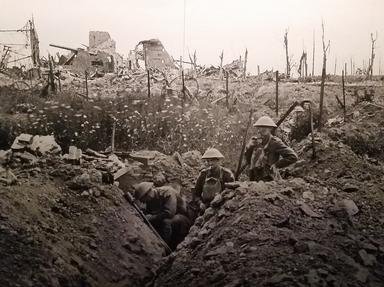Quiz Answer Key and Fun Facts
1. Lenah Higbee, in the United States Navy, grew the Nurse Corps from just over 150 to 1,300 nurses. She led the Corps through WWI. This involved training, deployment, and handling everything from wounds to pandemics. For all of this she was awarded the Navy Cross. What else was named in her honor?
2. Flora Sandes was the only British woman to officially serve as a soldier in the trenches during WWI. When Britain would not allow her to go to the front, she joined a different army. In what country's army did she perform so well she was promoted to sergeant-major?
3. Edith Cavell, a British nurse who ran a Belgian health clinic, was executed by Germany for aiding the enemy.
4. Maria Bochkareva was a Russian soldier who fought on the front. She faced enemy artillery, rescued wounded from dangerous places, volunteered as a scout, and lived on almost no food and little water. What was the name of the 300 woman-only group of soldiers she commanded?
5. Louise Thuliez was a French schoolteacher who became an important part of the French Resistance in WWI. When she was captured in 1915 by the Germans, she spent the next three years in what German POW camp/prison in the North Rhine?
6. Marthe Cnockaert, from Belgium, was a trained nurse. When WWI commenced and Belgium was occupied, she worked at the local hospital where she treated Belgian and German soldiers. What other occupation did she take on during this time?
7. Julia Stimson, born into an elite family in New England, rose the through the Army ranks to become superintendent of the whole American Army Nurse Corp in Europe during WWI. She was also the first woman to become what rank in the U.S. Army?
8. The hospitals established in Europe in WWI under Dr. Elsie Inglis were entirely staffed by women.
9. Evalina Haverfield was the daughter of a Scottish baron, and a married mother of two sons. She was also very involved in women's suffrage. When WWI began, she founded the Women's Emergency Corps and went abroad to help others. She spent much time in Serbia during this time and focused on what part of the society there?
10. Dame Helen Gwynne-Vaughn was an aristocrat from London and a pioneer in the study of fungi genetics. She led the Women's Army Auxiliary Corps in 1917 and then in 1918 she became the head of the women's division of what military branch?
Source: Author
stephgm67
This quiz was reviewed by FunTrivia editor
trident before going online.
Any errors found in FunTrivia content are routinely corrected through our feedback system.
